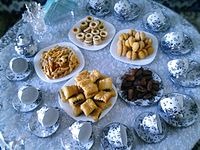A | B | C | D | E | F | G | H | CH | I | J | K | L | M | N | O | P | Q | R | S | T | U | V | W | X | Y | Z | 0 | 1 | 2 | 3 | 4 | 5 | 6 | 7 | 8 | 9
| Eid al-Fitr | |
|---|---|
From top: Muslims performing the Eid prayer at Suleymaniye Mosque, Istanbul, Turkey; cakes and sweets, which are popularly consumed during the celebration in Algeria; a sparkler being lit during Eid celebrations in Indonesia | |
| Official name | Arabic: عيد الفطر, romanized: Eid al-Fiṭr |
| Also called | Festival of Breaking the Fast, Lesser Eid, Sweet Eid, Sugar Feast |
| Observed by | Muslims |
| Type | Islamic |
| Significance | Commemoration to mark the end of fasting in Ramadan |
| Celebrations | Eid prayers, charity, social gatherings, festive meals, gift-giving, dressing up, Lebaran |
| Date | 1 Shawwal[1] |
| 2023 date | 21 – 22 April[a][2] |
| 2024 date | 10 – 11 April |
| Related to | Ramadan, Eid al-Adha |
| Part of a series on |
| Islamic culture |
|---|
| Architecture |
| Art |
| Clothing |
| Holidays |
| Literature |
| Music |
| Theatre |
Eid al-Fitr (/ˌiːd əl ˈfɪtər, -trə/; Arabic: عيد الفطر, romanized: Eid al-Fiṭr, lit. 'Holiday of Breaking the Fast', IPA: )[4] or the Festival of Sweets is the earlier of the two official holidays celebrated within Islam (the other being Eid al-Adha). The religious holiday is celebrated by Muslims worldwide because it marks the end of the month-long dawn-to-sunset fasting of Ramadan.[5] It falls on the first day of Shawwal in the Islamic calendar; this does not always fall on the same Gregorian day, as the start of any lunar Hijri month varies based on when the new moon is sighted by local religious authorities. The holiday is known under various other names in different languages and countries around the world. The day is also called Lesser Eid, or simply Eid.[6]
Eid al-Fitr has a particular salat (Islamic prayer) that consists of two rakats (units) generally performed in an open field or large hall. It may only be performed in congregation (jamāʿat) and features seven additional Takbirs (raising of the hands to the ears while saying "Allāhu ʾAkbar", meaning "God is the greatest") in the Hanafi school of Sunni Islam: three at the start of the first rakat and three just before rukūʿ in the second rakat.[7] Other Sunni schools usually have 12 Takbirs, similarly split in groups of seven and five. In Shia Islam, the salat has six Takbirs in the first rakat at the end of qira'a, before rukūʿ, and five in the second.[8] Depending on the juristic opinion of the locality, this salat is either farḍ (فرض, obligatory), mustaḥabb (strongly recommended) or mandūb (مندوب, preferable). After the salat, Muslims celebrate the Eid al-Fitr in various ways[9] with food ("Eid cuisine") being a central theme, which also gives the holiday the nickname "Sweet Eid" or "Sugar Feast".[10][11]
Native names
| Language | Name | Meaning |
|---|---|---|
| Acehnese | Uroë Raya Puasa Rojar Id | "Festival of breaking fasting" |
| Albanian | Fitër Bajrami, Bajrami i vogel |
"Big festival" |
| Arabic | عيد الفطر 'Īd al-Fitr | "Happiness of breaking fasting" |
| Assamese | ৰমজান ঈদ Romzan Īd | "Eid of Ramadan" |
| Bengali | রোজার ঈদ Rojar Īd | "Eid of the fasting" |
| Bosnian | Ramazanski Bajram | |
| Chinese | 開齋節(traditional) 开斋节(simplified) Kāi zhāi jié |
"Festival for the end of fasting"
Zdroj:https://en.wikipedia.org?pojem=Hari_Raya >Text je dostupný pod licencí Creative Commons Uveďte autora – Zachovejte licenci, případně za dalších podmínek. Podrobnosti naleznete na stránce Podmínky užití. Zdroj: Wikipedia.org - čítajte viac o Hari Raya
Text je dostupný za podmienok Creative
Commons Attribution/Share-Alike License 3.0 Unported; prípadne za ďalších
podmienok. |




